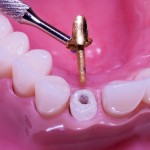
The use of intra-radicular posts may be necessary to provide retention and support for the restoration of endodontically treated teeth. Posts are available in a range of materials, metal (cast or prefabricated), fibre or ceramic. While studies and reviews of the performance of different types of posts have been conducted there is a lack of consensus on their performance.
The aim of this review was to evaluate the difference between fibre and metal posts or endodontically treated teeth.
Methods
Searches were conducted in the Cochrane library, Medline/PubMed, OpenGray, Proquest, Scopus, and Web of Science databases. This was supplemented by hand searches of the journals Clinical Oral Investigations, International Endodontic Journal, Journal of Dental Research, Journal of Dentistry, Journal of Endodontics, Journal of Prosthodontics, Operative Dentistry, The Journal of Prosthetic Dentistry. Randomised controlled trials (RCTs) and prospective clinical trials (PCTs) were considered.
Two reviewers independently searches and selected studies with one reviewer extracting data that was checked by a second reviewer. Risk of bias was assessed by two independent reviewers using the Cochrane domains-based tool for RCTs and the ROBINS-I tool for PCTs. Grading of Recommendations Assessment, Development and Evaluation (GRADE) approach was used to assess the certainty of the evidence. Meta-analysis was performed using the Mantel–Haenszel method with subgroup analyses for region of the mouth, type of post, complications and study design.
Results
- 10 studies (6 RCTs, 4 PCTs were involving 704 patients were included.
- Two RCTs were considered to be at low risk of bias and 4 at unclear risk. While 2 of the PCTs were considered at moderate risk and 2 at low risk.
- 844 endodontically treated teeth had posts placed 453 fibre posts (FP) and 391 metal posts (MP).
- 400 posts (210 FP,189 MP) were placed anteriorly and 413 (208 FP, 161 MP) posteriorly.
- Meta-analysis (10 studies) showed no significant difference in failure rates, Risk ratio (RR) = 0.82 (95%CI; 0.52 to 1.29).
- Subanalyses are shown in table below.
| No. of studies | Risk ratio (95%CI) | |
| Anterior restorations | 6 | 0.88 (0.54 to 1.42) |
| Posterior restorations | 5 | 1.18 (0.71 to 1.98) |
| Fibre post v cast post & core | 5 | 0.63 (0.23 to 1.72) |
| Fibre post v prefabricated metal posts | 5 | 0.90 (0.54 to 1.50) |
| Root fracture; FP v MP | 5 | 0.78 (0.41 to 1.49) |
| Debonding; FP v MP | 5 | 1.27 (0.57 to 2.80) |
- The GRADE certainty of the evidence was assessed as low.
Conclusions
The authors concluded: –
No evidence of difference was observed for failure rates between fibre posts, and metal posts, independent of region and different metal posts used in endodontically treated teeth. However, further well-conducted clinical studies with high-quality evidence are encouraged.
Comments
The authors have registered their protocol on PROSPERO and conducted a broad database search supplementing it with a search of relevant journals deciding to include both randomised and non-randomised trials. 10 studies sere included with a majority (6) being RCTs. Previously we highlighted a 2016 review by Sorrentino et al (Dental Elf -12th Sep 2016) which included 4 RCTs, only one of which is included in the current review. Interestingly there is a difference of opinion regarding the quality of the trial common to both reviews in that Sorrentino considered it to be a high risk of bias while the authors of this review only consider it to at unclear risk. The follow up periods ranged form 12-154 months with 2 out of the 3 studies reporting just 12 months follow up having no failures. Overall, the analysis suggested no differences in outcomes between the two main types of post assessed. Future RCTs should be well conducted and reported following SPIRIT and CONSORT guidance and include a common outcome set (COMET).
Links
Primary Paper
Martins MD, Junqueira RB, de Carvalho RF, Lacerda MFLS, Faé DS, Lemos CAA. Is a fiber post better than a metal post for the restoration of endodontically treated teeth? A systematic review and meta-analysis. J Dent. 2021 Jul 16;112:103750. doi: 10.1016/j.jdent.2021.103750. Epub ahead of print. PMID: 34274439.
Other references
Dental Elf -12th Sep 2016
Dental Elf – 26th Nov 2014
